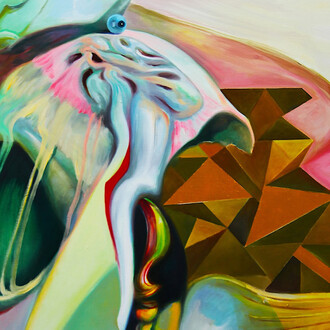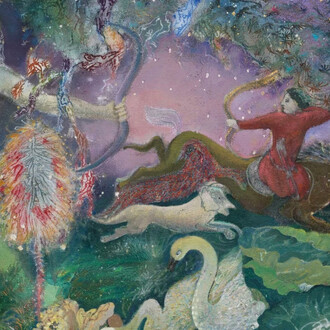Art in love presents new paintings and drawings by Gaby Collins-Fernández. Through digital and physical manipulations of familial, personal, and art historical imagery, the artist considers abstraction fundamental to contemporary image culture, and the capacity of painting to present and participate in these questions.
Collins-Fernández does not start from scratch, literally or conceptually. Visual and social inheritances determine her source imagery, from family photos and sexy selfies, to snapshots of historical paintings. These are altered and collaged in Photoshop, often to painterly effect, before being printed onto fabrics like chiffon, organza, and beach-towel microfiber. She physically cuts and sews the fabrics together, and then stretches and prepares them to be painted with oil and acrylic paint. The imagery, while densely arranged in each painting, is iterative. Most of the images have been a part of the artist’s visual lexicon for many years, and find their way into multiple paintings and works on paper. Elements become familiar across different surfaces—an hourglass form, a photograph of a girl in a plaid shirt with her butt exposed, a classical figurine, a particular kind of lattice—insisting that meaning is made both within and between the edges of artworks.
Art in Love is a title which begs the question of affect and earnestness. Painting is famously self-referential: it builds language even as it might turn inward. In this way it has a strong correlation with the algorithmic experience of social media and digital interfaces, which seemingly expand outward as they create personal bubbles. These ideas further Collins-Fernández' interest in the Baroque as an aesthetic and colonial process, defined by excess, artifice, and repetition; and its relationship to an affective digital imaginary marked by similar tendencies. This history relates to the artist’s personal background, as a child of the 90s raised in a mixed Cuban-American family in New York City, surrounded by a diasporic and urban sensibility.
As a style, the Baroque is referential and associative, and structures images as “types” within an over-abundant optical and material field. Collins-Fernández uses this logic to structure her work, as a way of organizing overwhelming and often contradictory information, from the comparison of a sexualized version of her body to older paintings (Titian, Bellini, and Rubens are referenced) and the anthropomorphic stem of a wine glass owned by her grandmother; to the use of overlays and blurs in Photoshop which are then replicated in paint; the arrangement of fabric into ruffles and drapes; and the inclusion of verbal text in the work as a kind of internal commentary.
The saturated visuality and sense of backlighting produced by sheer fabrics evokes digital space and also invokes feminist concepts of painting projecting into the personal space of the viewer; the colorful palette and range of painterly and material gestures engage high style as readily as "bad taste". In the tradition of artists like Elizabeth Murray and Ree Morton, Collins-Fernández insists that humor and sentiment can ground a conceptual take on painting’s history, materiality, and ability to present ideas about subjectivity. Similarly, the idea of art in love inverts the traditional expectation of a viewer's affection for art as its ultimate goal, into a space where a viewer might ask: does art have the agency to be in love, and with what? The question remains unanswered, intentionally, as a humorous and serious proposition, intended to encourage further engagement with conventions of painting and taste. What should art be, if not in love? What are the visual and ideological structures that allow art to be in love? And once affect is engaged, can painting describe the visual and emotional structures of contemporary life? If these questions sound abstract, it is because they are. Collins-Fernández makes a case for abstraction as a tool to process what we recognize, represent, and even love.
Gaby Collins-Fernández (b. 1987, New York, NY) is an artist who navigates aesthetic inheritance by drawing from historical and personal image archives. Known for her distinctive approach to mixed-media painting, her process begins digitally, creating photocollages that merge self-portraits and art historical images, extensively manipulated using Photoshop. She received a B.A. from Dartmouth College and an MFA in Painting & Printmaking from the Yale School of Art. Her work has been shown in the US and internationally, including at Peter Freeman, Inc., the Birmingham Museum of Art, and el Museo del Barrio. Her work has been discussed in publications such as The Brooklyn Rail and artcritical, and on the video interview series, Gorky's Granddaughter. She is a recipient of residencies at Yaddo (Saratoga Springs, NY), The Marble House Project (Dorset, VT), and the Elizabeth Murray Art Residency (Granville, NY), and a 2013 Rema Hort Mann Foundation Emerging Art Award. She was also a 2023-4 resident of the Sharpe-Walentas Studio Program. Collins-Fernández is also a writer whose texts have appeared in Cultured Magazine, The Miami Rail, and The Brooklyn Rail. She is a founder and publisher of the annual magazine Precog, and a co-director of the artist-run art and music initiative BombPop!Up. Collins-Fernández lives and works in New York City.
















